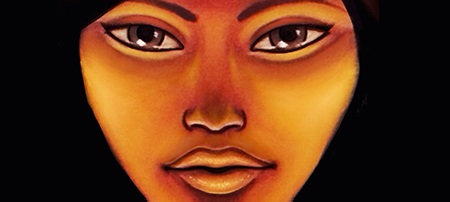
[touch the earth]
Two spiritualities meet each other
~ the good, the bad - of what Europeans brought ~
and the people labelled "white"
White man brings his Book : European culture invades native simplicity.
Hosted free by tripod.com

~ the good, the bad - of what Europeans brought ~
The Puritans' missionary efforts among the Indians, unlike the Virginia Anglicans, achieved some (modest) success. The Puritan minister John Eliot spent his entire career in Massachusetts seeking conversions among the Indians. The Puritans published more than twenty Christian books in the Massachusetts (Indian) language between 1654 and 1690, including a complete translation of the Bible in their tongue. Native Indians who had converted to Christianity themselves preached among other Indians. By 1674 more than thirty so-called 'praying towns' of Christian Indians dotted Massachusetts.
But all that came to an end with King Philip's War.
The so-called King Philip's War of 1675-76 effectively ended Eliot's work. In 1655, Indians led by Metacom attacked English (Puritan) settlements. They devastated 25 English (Puritan) villages, destroyed more than 1,000 English (Puritan) homes, and killed at least 2,000 English (Puritan) men and women, as well as 8,000 cattle.
The whites counterattacked vengefully, killing Metacom and upward of 7,000 Indians, some in battle, others by starvation and disease. They reduced the number of the 'praying towns' to four, several of which quickly disbanded.
A success story: Père Isaac Jogues
Most importantly, as one Jesuit put it, the French fathers used "mildness and force, threats and prayers, labors and tears." They understood that conversion was an emotional as well as a logical process. As one Jesuit put it, "In order to convert these peoples, one must begin by touching their hearts, before he can convince their minds."
Father DeSmet
It was said of Father De Smet that, like the Quakers of old, he alone "of the entire white race could penetrate to these cruel savages and return safe and sound." See outline history.
The Moravian missionaries in New York and Pennsylvania likewise encountered considerable success. Like the Jesuits, the Moravians made a point of learning much about the native cultures and exhibited considerable patience in awaiting conversions. They also distanced themselves from the aggressive actions and attitudes of the borderer frontier settlements with their hard-drinking, Injun-hating, and sometimes Calvinist-spouting mores and values.
Most importantly, Moravian theology fit the realities of the conversion process and important themes in traditional native beliefs. Inspired by Quakers, Moravians envisioned unity among all Christians as an ideal of Christ-like harmony. They practiced, like the Quakers, a "peace" ethos, but never rebelled against the traditionalism of the Lutheran practice, in the way that other "peace churches" (Anabaptist Brethren, Dunkers, Amish,Mennonite) chose to do.
As pietists and quietists, Moravians stressed "living" the Word, calling for believers to "embody" the love of Christ, preaching as much by example as by instruction. Like the Quakers but unlike the Puritans, Moravians did not stress doctrine. They lived among the Indians and used native language in day-to-day conversation, not merely in translated books. Like Native Americans, they discussed how dreams could communicate religious truths and moral lessons.
An Irish Calvinist Ulsterman in Pennsylvania commented enviously, "The Moravians appear to have adopted the best mode of Christianizing the Indians. They go among them without noise or parade, and by their friendly behavior conciliate their good will." The Moravians are classed as a form of Pietism with Rosicrucian influences in evidence.
As one Quaker remarked, "To reach the full-blooded Indian send after him a full-blooded Christian. [Quoted by William T. Hagan p129]
Letting their light shine: the missionary impulse
The Massachusetts Bay Company, which held the charter to the colony of Massachusetts, featured an Indian carrying a bow and arrow standing between two pine trees and saying, 'Come over and help us.'
By comparison, the French priests who brought (Catholic) Christianity to the Indians in America proved substantially more successful. [Père Isaac Jogues, etc. See Pope John Paul's tribute.] The French missionaries worked more patiently and learned more about native customs and life, not just the native language. They indulged a greater longevity among converts of a kind of syncretism, retaining elements of traditional native lore and custom alongside their deepening introduction to Christian belief.
Jon Butler, Grant Wacker, & Randall Balmer:
Religion in American Life

The world around us is filled with everything we need |
___
Why are some outcasts able to see more clearly, or with more simple human compassion, than those who persecute them? Roger Williams, having been kicked out of Massachusetts Bay Colony by the religious authorities, sought refuge among his old friends the Indians (what was to become Rhode Island). When the governor of Massachusetts arranged for his return, Williams declined, explaining: "I feel safer down here among the Christian savages along the Narragansett Bay than I do among the savage Christians of Massachusetts Bay Colony." Martha Nussbaum writes that Williams never tried to convert the Indians. He recognized the values and moral excellence they already possessed, and accorded them the compliment "Christian" though they continued their own ancient observances [Liberty of Conscience. p47]
Enslavement of Natives in California Anointing themselves (as white men) as "gente de razon," (more intelligent than the 'savages') Christian missionaries like Father Junipero Serra set out to make the native populations slaves to the farms supporting the missions. Spanish soldiers kidnapped Indians by the thousands. They were given Spanish names, dressed in blue uniforms and became farm workers -- something they had never done. They also were forced to care for livestock, tanned hides, and produced candles, bricks, tiles, shoes, saddles, soap and other necessities.
If they misbehaved, they were whipped, branded, mutilated, tortured, flogged -- or even executed. Hundreds and thousands of Indians -- both in the missions and in surrounding areas -- died of malaria, smallpox or other new diseases imported by the Spanish for which there was no native immunity. In Genocide and Vendetta, Lynwood Carranco describes how Indian women of northern California were traded to vaqueros (coastal southern California) for Spanish horses. See more.

The soreness of the land - the prophecy of Kate Luckie, Wintu Spirit WomanThe bridge is love ~ native spirituality is the wordless song of the heart
"Town Destroyer" George Washington impresses the eastern sachems
Iroquois Constitution (The Great Law of Peace) influenced the U.S. Constitution, historians sayWisdom of the Great Chiefs - native words still speak from long ago
Chief Seattle's oration, 1854 - I first encountered this speech in Norton's reader.
Never Give Up. The native American saga of hope and triumph.
Walking with Grandfather : rethinking past rejection of Native Wisdom - Michael Hardin (adjusting his views)
Strange Correspondences Between Aboriginal American Cultures And Ancient Hebrew and Shemite Tribes
Where Are the Children? - healing the legacy of the Native residential schools in north America
Civilize them with a stick - Mary Crow Dog's Harrowing Story of Brutality, and Survival
Indian Boarding Schools the girls experience, forced Christianity, abuse, even being stripped naked and horse whipped
Kate Luckie - Earth Mother Crying two spirit woman tells how Mother's children make her weep
Beautiful Outcasts - these quiet rebels, the "Friends" (Quakers)
John Marrant, black apostle to the Cherokee - having credibility with Native folk, God used him greatly
John Stewart "Man of Color" - Adopted into the Wyandotte people as one of their own; he let his light shine
Black Indians -- An American Story - a forgotten part of America's past : the cultural & racial fusion of Native & African Americans.
A prophet named Shining Shirt (Kalispel tribe) - foresaw coming of white man
The American Indian Heritage Foundation Providing relief services to native peoples
Residential Schools for Native Children [abuse, whippings, etc] Canada's lasting shame
NARF : Native American Rights Fund - 38 years of standing firm for justice.
Hanksville - index of Native American resources on the internet.
The Tall-one (Geo. Washington) - when your worst enemy turns out to be a best friend.
Medicine - the gospel light (spirituality resources)
Respect Runs Deep - offered by indians.org = Native American Spirituality
Honoring our roots - history re-enactments and rendezvous of the Rocky Mountain fur trade

Most of the missionaries and teachers were selfless, dedicated people who labored uncompromisingly and were relatively unrewarded. Unfortunately, the contempt many of them felt fo r Indian culture did not prepare them for their work. There were instances of individuals, like the Pawnee agency employees in the 1840's, whose superiority complex was so overwhelming that they did not hesitate to inflict corporal punishment on Indians for minor transgressions of a code alien to the red man. [American Indians, p90]
Fyodor Dostoyevsky writes on the Children of the Sun
The children of the sun, the children of their sun -- oh, how beautiful they were! Never had I seen on our own earth such beauty in mankind. Only perhaps in our children, in their earliest years, one might find, some remote faint reflection of this beauty. The eyes of these happy people shone with a clear brightness. Their faces were radiant with the light of reason and fullness of a serenity that comes of perfect understanding, but those faces were gay; in their words and voices there was a note of childlike joy.
----
They had no temples, but they had a real living and uninterrupted sense of oneness with the whole of the universe; they had no creed, but they had a certain knowledge that when their earthly joy had reached the limits of earthly nature, then there would come for them, for the living and for the dead, a still greater fullness of contact with the whole of the universe. They looked forward to that moment with joy, but without haste, not pining for it, but seeming to have a foretaste of it in their hearts, of which they talked to one another.
Ronald Sanders discerns a Celtic spirit in the more benign attitude which some northern Europeans exhibited to Native Americans. Sanders contrasts Celtic benevolence with the Germanic tendency to dominate. One might say that when the French and the English attacked and conquered the American Savage, they were behaving like the Teutonic elements in their own respective histories, violent, restless, uprooted wanderers from the East. But when they admired his rustic tranquility and unerring grasp of a life in harmony with nature, when they felt compassion for the simplicity of the man of the northwest whom they were now beleaguering, they were harking back to their Celtic ancestry, and being reminded of its surviving enclaves in their own metropolitan north and west -- Brittany in France; Ireland, Wales, and Scotland in the British Isles. It is significant that when the British began seeking the earliest possible sources for their claims upon North America, their favorite myths were Celtic: not only St. Brendan, but more emphatically Prince Madoc, a twelfth century Welshman who was said to have founded an American colony and whose lineage was persistently perceived among some Indians by a tradition of enthusiasts down to very recent times. [p202. Lost Tribes and Promised Lands]
GeoCities Site Maintained by Robert Shepherd
photograph
| Feisty journalist commentator Andy Rooney wrote a column in 1992 that posited that it was "silly" for Native Americans to complain about team names like the Redskins, in which he wrote in part, "The real problem is, we took the country away from the Indians, they want it back and we're not going to give it to them. We feel guilty and we'll do what we can for them within reason, but they can't have their country back. Next question." |
last save 12.23.11
last save 03.31.15